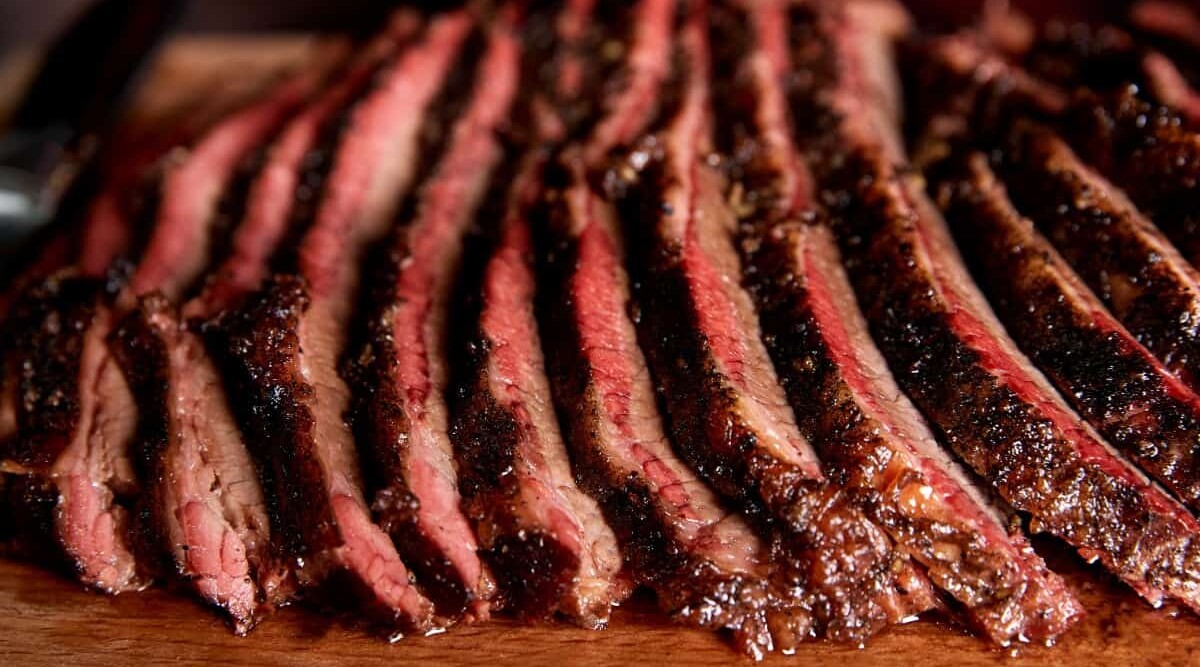
Where do you think the best barbecue in the world is cooked? If you guessed Texas you’d be right, but do you know the exact restaurant that is widely considered to be number one?
The answer may surprise you!
Franklin Barbecue of Austin, TX is considered by many to be the best BBQ you will ever find.
What makes it surprising is that Pitmaster Aaron Franklin opened his restaurant in a trailer on the side of Interstate 35 in 2009. He quickly gained a cult following, and the rest is history.
That’s right, the best BBQ restaurant in the world has been around less than a decade, and is owned by a man not yet 40.
And what is this world-famous pitmaster most known for? The Aaron Franklin brisket recipe, salt and pepper rubbed, wrapped in pink butcher. And in this article, we’re going to showcase this recipe, with simple to follow instructions, so you can recreate it at home.
How to Cook the Aaron Franklin Brisket Recipe at Home
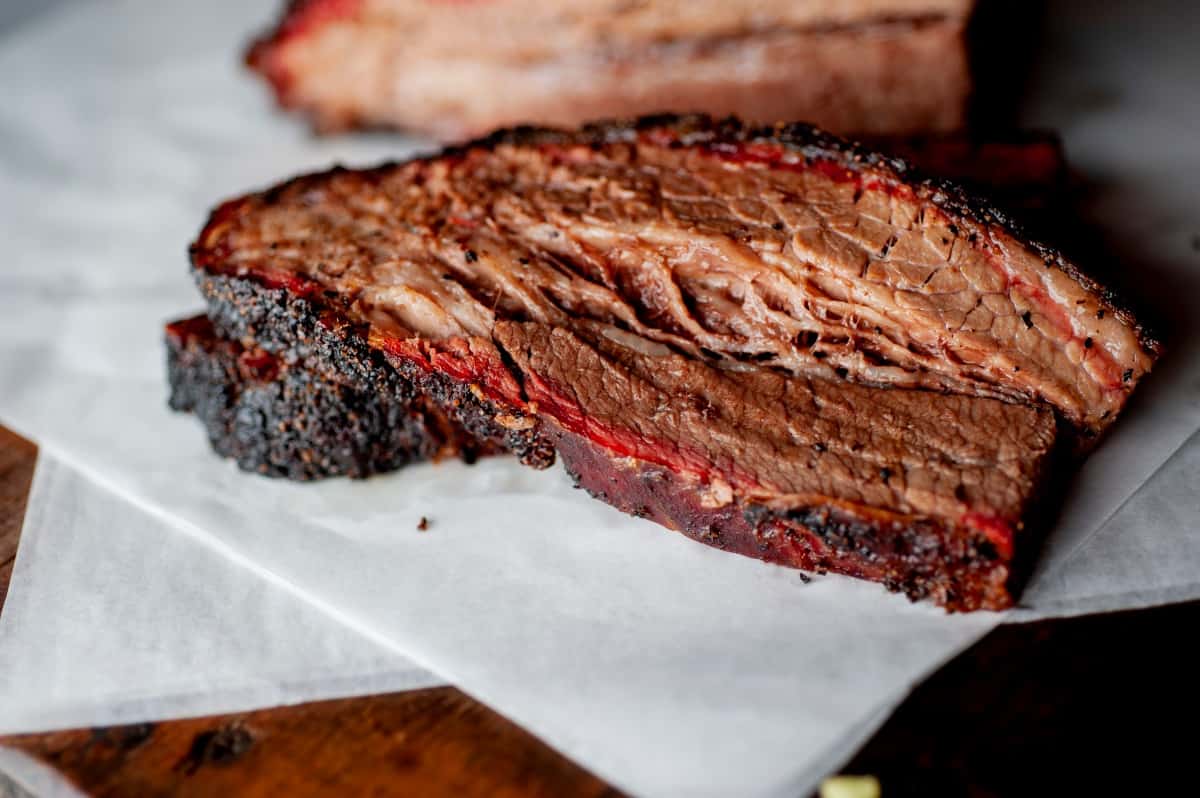
If you’ve read this far, I wouldn’t be surprised if you wanted to try and make a brisket yourself, and use as many of Aaron’s techniques as possible.
While it will likely take a lot of practice, you can make a pretty dang good brisket in your own backyard, by using most of the tools and techniques found in Aaron Franklin’s brisket recipe
Tools
For starters, you’re going to need the right tools to do the job. While you have many choices of cookers to use, if you want to come as close as possible to following Aaron’s methods, you’re going to want an offset smoker. You don’t need a $10,000 rig or anything; a simple Oklahoma Joe can be had for a couple of hundred bucks.
If for some reason you’re unable to use an offset smoker, you can easily use any charcoal grill that allows you to set up for two-zone indirect cooking. Which means almost any grill will work, from the iconic Weber Kettle, to bullet style smokers, to kamados like Big Green Egg/Kamado Joe.
Lastly, you’re going to either need post oak or oak logs or chunks. If you’re using an offset smoker, logs will be your preferred wood, if using a charcoal grill, chunks will be what you need. You should use oak if you want to stay true to Aaron’s recipe, though if you want to go slightly off-piste, you can use alternatives as discussed in our article on the best wood for smoking brisket.
Ingredients
As mentioned, Franklin uses Prime briskets, which are very expensive and are certainly not affordable for everyone. If you can’t find Prime, at the very least you should use ‘Choice’.
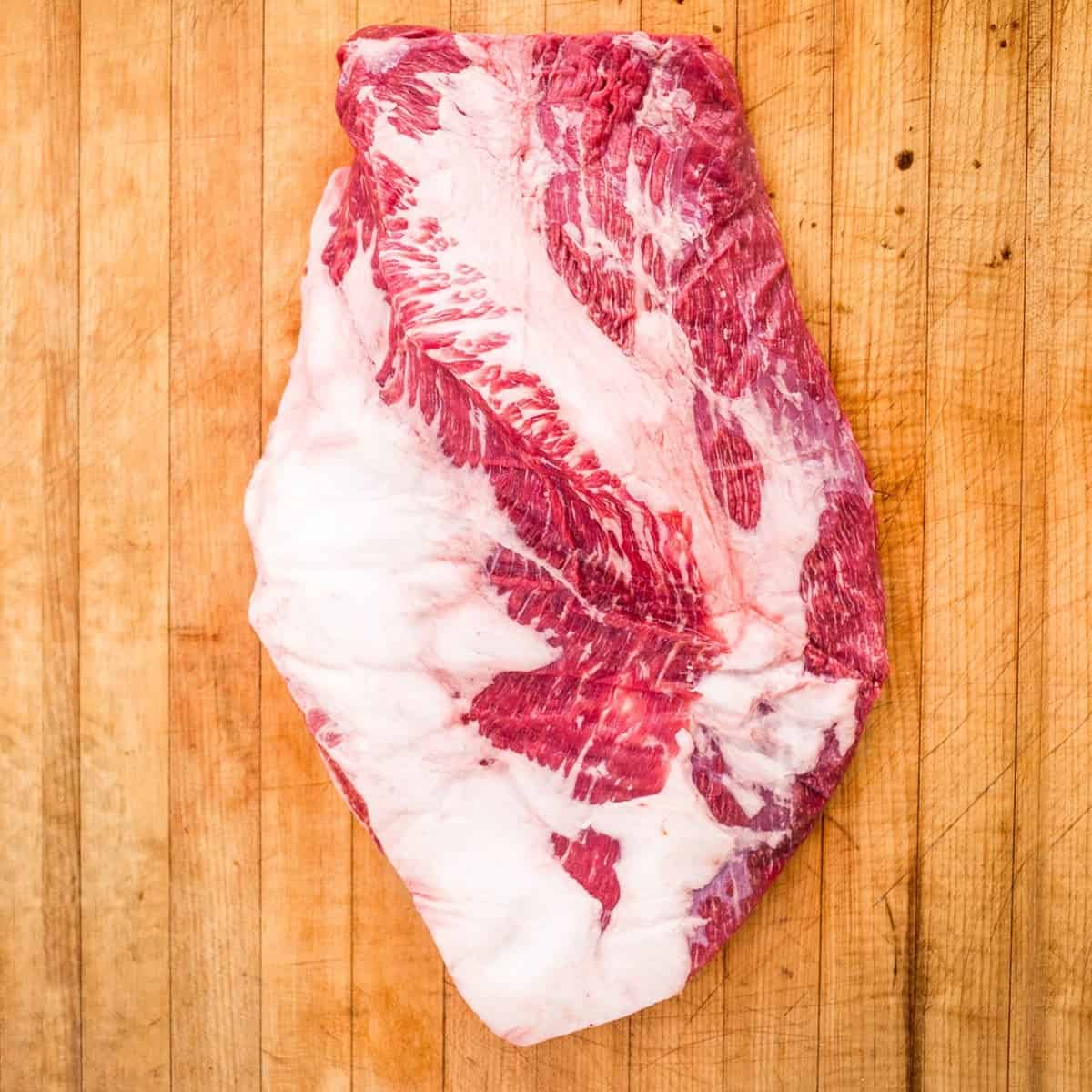
These dry-aged Briskets are sent to you trimmed minimally, so you can prep them just the way you like.
For seasoning, it’s easy to copy the traditional half-and-half kosher salt/16 mesh ground pepper rub. Simply combine a couple of tablespoons of each into a shaker and put on the brisket. You don’t want to go too heavy here, else you might over season. Just focus on giving the brisket an even coat. But you can also choose any other brisket rub of your liking.
In Aaron’s brisket recipe, there is — in addition to adding a water pan to the cooker -mention of spritzing your brisket with a liquid to help keep the meat moist. Any liquid can be used to make a spritz, but he recommends using apple juice and water.
Trim the Brisket
If you watch a lot of YouTube video’s on barbecue, you’ll see an awful lot of professionals simply over trimming cuts like brisket. That’s why it’s refreshing to see Aaron put out a video with a simpler approach to trimming.
In short, you’re going to trim the fat cap down to ¼” thickness and remove any larger pieces of fat, since they will simply not cook down.
In particular, you’re going to want to pay special attention to large pieces of hard fat that connect the point to the flat, because they will never cook down. For a bit more detail on how to trim like Franklin, watch the above YouTube video, or check out our guide on how to trim brisket.
The Cook
Once you’ve lit your fire and added your meat, it’s time to sit back, grab a book, and make the most of your day. The brisket is going to take the better part of the day to cook, so you can’t make plans to head out and run errands. Depending on your cooker, you might want to cook your brisket fat side up or down, read that article to get the best advice. But the summary is: Most grills fat side down, offset smoker fat side up.
Every hour or so, you’re going to want to check your fire, make sure you don’t need to add another log or charcoal, and also take the opportunity to spritz your meat.
In the videos Aaron does not make mention of internal temps of the meat very often. Since he cooks the same type of briskets day in, day out, he can tell when they are progressing and when it is time to wrap the briskets, just by feel. It won’t be as easy for you.
A general rule of thumb is to insert a food thermometer, and when the internal temp reaches 165 °F, it’s time to wrap it.
As discussed, Aaron uses butcher paper to wrap his brisket, and you can too, or you could wrap it in tinfoil if that’s all you have. The purpose of the paper is to help the brisket braise in its own liquid and speed up the final steps of the cooking process, pushing the brisket through the stall and beyond, until the final desired internal temp.
Once your brisket has reached an internal temperature of approximately 200 °F – 205 °F, you’re going to want to check for tenderness. If a digital thermometer probe can slide in and out like butter, you’re golden.
Faux Cambro — Or a Real One
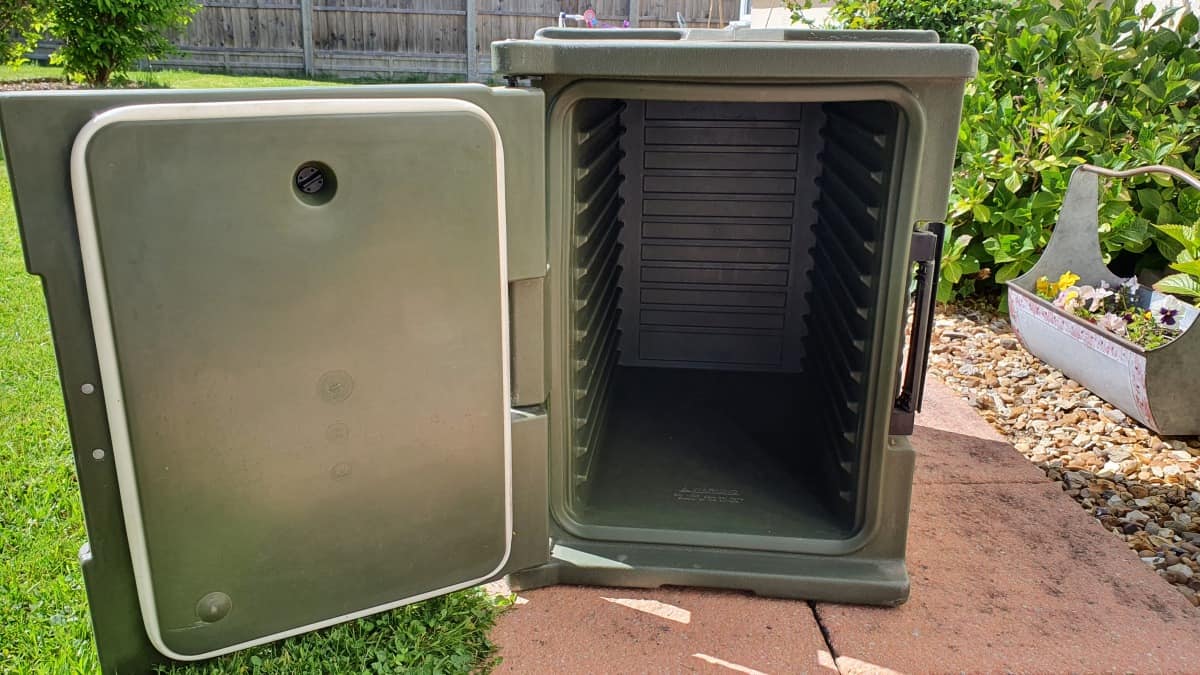
A Cambro is a brand name of food warmer, frequently used by caterers to transport food and keep it hot. Unfortunately, a Cambro can be very expensive, but there is a cheap alternative (a faux Cambro so to speak)– a dry cooler.
Once you’ve removed your (still wrapped) brisket from your cooker, you’re going to want to place your meat into a cooler for a rest.
This time resting will allow for the liquid inside the brisket to come down in temp and not come running out of your brisket when you slice it.
Carving
Aaron does an excellent job describing how to properly slice a brisket in the last video. He starts by reminding you of the two cuts in a brisket, the flat and the point, which is discussed in great detail in our article on brisket flat vs point. From there he explains that you’re going to want to slice both cuts against the grain.
Starting from the flat, Aaron slices brisket roughly as thick as a pencil.
When sliced the brisket is able to hold itself under its own weight, but when lightly tugged can easily be pulled apart. Aaron also explains that he keeps the brisket together as he is slicing to keep the slices from losing moisture, oxidizing, and drying out.
Once he gets to the point of the brisket, Aaron turns the meat 90° to continue slicing against the grain. He also slices it a little thicker than the flat, about 3/8”.
Leftovers
A whole packer brisket is a huge chunk of meat, and unless you are feeding a large crowd, there are bound to be leftovers.
The problem with leftover brisket is that it dries out quickly and is typically made worse during reheating.
But fear not, check out our article on how to reheat brisket to achieve results comparable to thcomparable to the day it was cooked
The Brisket
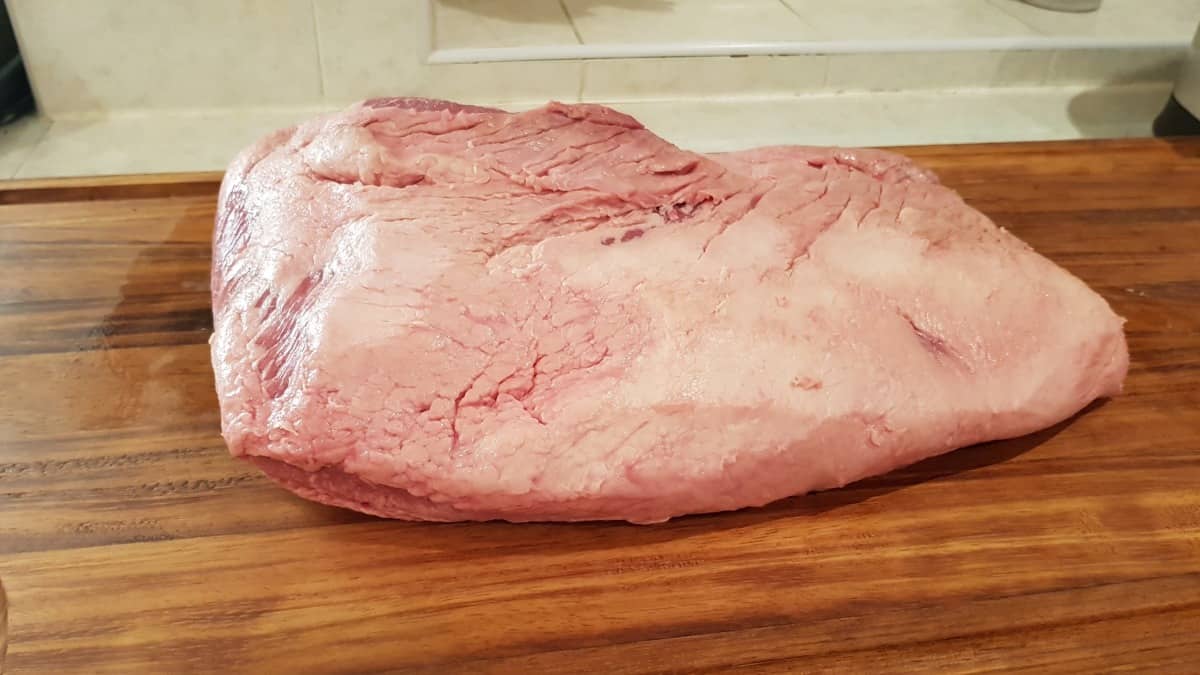
What undoubtedly bring most patrons to Franklin Barbecue, is the promise of low n slow smoked brisket unlike they’ve ever had before.
In central Texas (where Austin is located), people traditionally like their barbecue cooked a certain way, and Aaron doesn’t stray from that.
They like their food to be cooked with Post Oak wood, and they love their salt & pepper. Below is a quick run-down of how Aaron cooks his brisket in his restaurant.
Finest Ingredients
Earlier I mentioned that Aaron did one thing from day one: his focus was on a second to none product, and he didn’t cut any corners. This meant using the highest quality ingredients he could find.
While most barbecue joints are cooking choice briskets (some might even be using select), in a recent interview with Thrillist Aaron explained he uses hormone free Prime grade beef. This is beef from cows that have not been pumped full of hormones and with the highest quality of marbling available.
For seasoning, simple salt and pepper are fine, although Aaron uses 16-mesh coarse grain pepper. Other than that, no fancy fixings are required.
For smoke flavor, traditional Central Texas BBQ uses Post Oak burned in an offset smoker. Franklin Barbecue is no exception, but Aaron does recommend against using green wood, or wood that hasn’t been properly dried first.
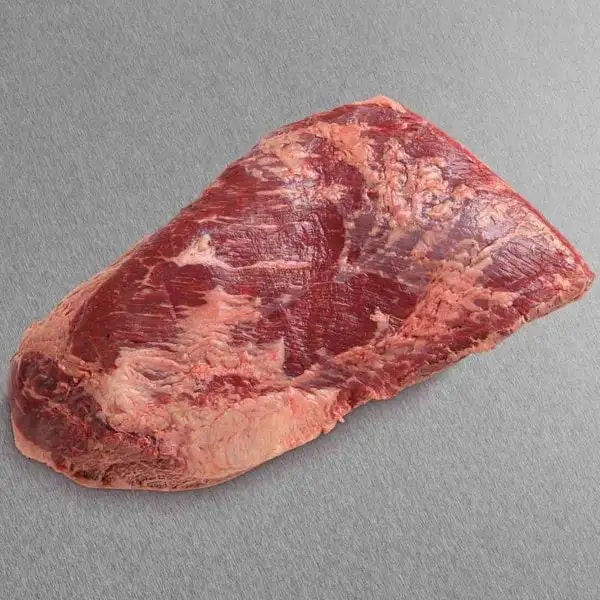
The “secret ingredient” for competitive barbecue teams gunning to be Grand Champion at all the top BBQ events. Beautifully marbled, hand selected and carefully cut to the latest NAMP guidelines.
Hardware
While many restaurants claim to serve barbecue from genuine smokers, many of them are producing half-hearted excuses for smokers using gas or electric ovens with smoke boxes attached to them. Franklin uses traditional offset smokers, built from things like old propane tanks.
They operate very simply: there is a firebox to one side and as the fire burns the attached chamber heats up cooking the meat, and smoke passes through the chamber flavoring the meat.
On top of using an offset smoker, Aaron adds a pan of water to his cook chamber. This helps add moisture and humidity to inside your cooker. A moist and humid-cooking environment will both prevent food from drying out and assist in smoke penetrating into the meat to give you a good flavor.
Patience
The last step for any brisket cook is patience.
A brisket is a large cut of meat and will take a long time to cook. Aaron suggests that when cooking at a temperature of 250 °F, a brisket will typically need an hour to an hour and a quarter per-pound. That is potentially a 12 to 15-hour cook right there.
Pink Butcher Paper
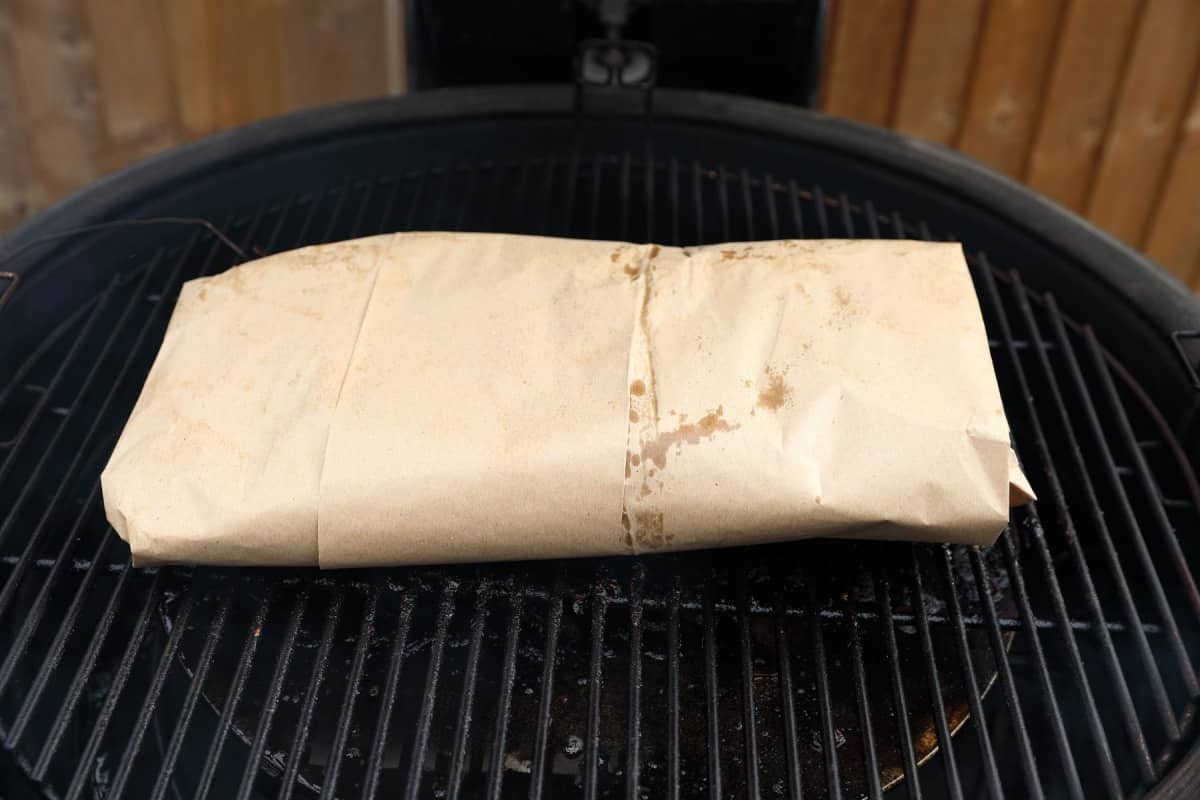
To help speed up the process, Aaron wraps his brisket in pink butcher paper (not foil) once it has reached the desired color, and places the meat back on the cooker.
As explained by Hardcore Carnivore Jess Pryles, Aaron learned this technique from his time working with John Mueller. John learned it from his dad, Bobby Mueller.
This paper is food grade and is beneficial in barbecue because it keeps the meat from drying out during the last stages of the cook, without potentially ruining the bark you’ve just spent hours forming such as happens when wrapping in foil.
Who is Aaron Franklin? A little History
While many of the great Texas barbecue establishments are family operations where they’ve been doing things the same way for decades, Franklin’s is a little different.
It is true that Aaron’s parents had briefly owned a barbecue restaurant when he was a child, and he’d worked for a brief period of time for John Mueller, grandson of the famous Louie Muller, patriarch of Louie Mueller Barbecue in Taylor, TX; but Aaron would be the first to point out he didn’t learn how to cook beef brisket by cutting onions and running a register.
Humble Beginnings
As already stated, Franklin Barbecue had incredibly humble beginnings. He and his wife Stacy initially opened the restaurant in a parking lot in Austin and ran it from a series of trailers.
One trailer held a smoker that had originally belonged to John Mueller, his former employer, and the second trailer was a 1960s travel trailer converted into a kitchen. It was here that the meat and sides were prepped and sold.
Right from the beginning, Aaron put a focus on creating a second to none product. He didn’t cut corners, and he used premium ingredients. As people began to taste his food, word quickly spread that his food was second to none, and he quickly gained a cult following.
Eventually, people started lining up outside the fence (since they were in a parking lot, they had to fence themselves in to keep things orderly) long before they opened. They’ve sold out of food every day since they’ve opened.
Expansion
As time went on, more and more people took notice of Franklin Barbecue and reviews began to come in fast and furious.
First social media and local Austin websites and blogs raved about the barbecue, then BonAppetit named it the best barbecue in the country, and not long after Texas Monthly magazine named it the best in Texas — which is pretty much also to say it is the best in the country.
In less than two years, Franklin’s had outgrown their small operation and began looking for a permanent location they could call home. When another BBQ restaurant closed not far from their existing parking lot setup, Aaron and Stacy jumped on the opportunity.
In their new location, they were able to up their capacity by adding more smokers. They eventually began taking pre-orders, so impatient patrons could skip the line altogether — with a minimum order of $100.
Yet, success caught up with them again. In 2014, they built an addition to their existing restaurant to house their smokers (up until then, the smokers were behind the restaurant), and they also added two new smokers — one a large rotisserie named Bethesda. This allowed them to increase their capacity and also make the cooking process a little easier for themselves.
James Beard Award, PBS, Book Deal
Since then, Franklin has continued to collect accomplishments not many classically trained chefs will see in a lifetime of professional cooking, let alone someone who went from hobbyist to professional.
In May 2015, he was nominated and awarded the prestigious James Beard Award for Best Chef: Southwest. He is the only barbecue restaurateur to be nominated for the award, let alone win.
After creating a series of web videos (more on that later) in 2013, PBS produced a 10 episode series titled “BBQ with Franklin.” Each half-hour episode followed Aaron around Texas, soaking up the different regional grilling cultures that make up Texas Barbecue.
Finally, Aaron penned his book “Franklin Barbecue: A Meat Smoking Manifesto,” an elaborate cookbook of sorts. In it, he gives his story of how he got to be where he is, as well as describe how to build pits like he uses in his restaurant, and how to cook his meats and create his signature sauces and sides.
So, just to recap: In less than 6-years, Aaron Franklin opened his restaurant in a parking lot, moved to a brick and mortar location, had to build an addition onto said brick and mortar, won a James Beard Award, wrote a cookbook, and oh yeah, starred in his own TV show.
Conclusion
Well, there you have it. The incredible history of Aaron Franklin, Franklin Barbecue, and his brisket.
Do you think we left any major parts out? Have you ever cooked a brisket before using his methods? Have you ever cooked a brisket before and thought your methods were better than his?
Make sure to tell us in the comments section below!
Happy grilling!


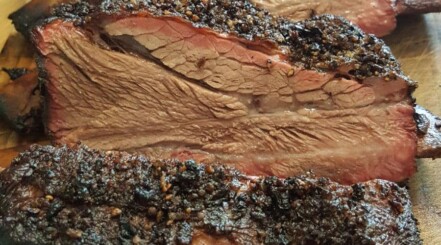
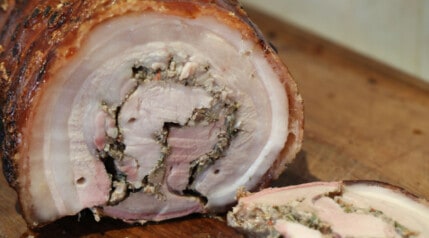
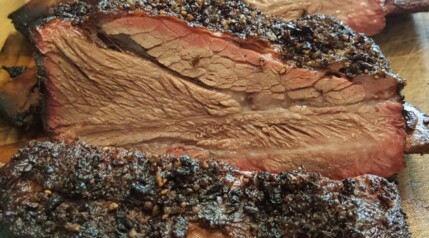
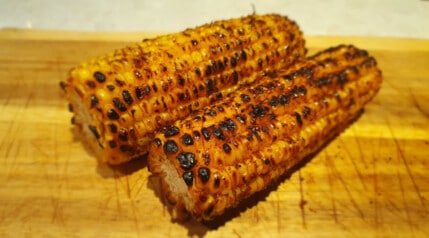
The Best, Jerry. The Best in the city…
Rodney Scott was another James Beard award winner for barbecue.
This is true. Aaron uses 1 part Lawry’s seasoned salt, 1 part coarse kosher salt, 1 part 16 mesh black pepper for rub on top of a blend of 1/1 yellow mustard and pickle juice. They also work temps up throughout the cook, starting low around 225 °F while notching temps up progressively throughout the cook, and finishing around 300 °F. Dude has been lying to you all for years, and isn’t gonna stop anytime soon.
Thanks for the information. I use a RecTeq pellet smoker, and I have found low and slow is the best way for me to cook my brisket. I cook the brisket at 225 °F.
I wrap the brisket in butcher paper at 165 degrees. I increase the grill temp to 245 °F at 185 °F internal temp. Then I pull it off the grill at 203 °F internal temp. I then place the wrapped brisket Into my ARTIC or YETI cooler, where the brisket will rest for 3 hours. The brisket turns out moist and very delicious. I have varied with several rubs, always searching for a better product. I’ve never had anyone not like my brisket. As a matter of fact, several people have asked me to open a restaurant or food truck, which is not in my plans. I’m just a weekend warrior on the pit smoker, who enjoys creating good food for people to eat.
Just my two cents.
Approximately how long on the grill? I also have a rec tec and i love it!
Great article. I smoke meat almost EVERY weekend. I LOVE TO SMOKE MEAT. TRI-TIP is good meat to smoke if you’re short on time. Also, try pork butt sliced into 2-inch steaks. It becomes a completely different piece of meat than a whole pork butt when you do it this way.
SMOKIN’.
When you put it in the cooler, wrapped.
I assume there is no ice. How long do you leave it in there?
Hi Joe,
No ice, no. You use the cooler’s insulation to keep the food warm, using it as a warmer, not a cooler.
Resting time is recommended to be at least an hour, 2 hours is preferable, and you can go longer, but you do not want the internal temperature dropping too far. Never let it go below 145 °F as this is unsafe for food hygiene reasons, but I would never let it drop below 165 °F because then it gets too cold too quickly after slicing and before serving.
The idea of using a ‘faux cambro’ is so that you can rest it longer without the internal temperature falling too much. You can then prepare (cook) the brisket ahead of time, keep it warmer for longer, and so plan further ahead to serve guests at the desired time.
Pretty widely known that Franklin’s “salt and pepper only” mantra is bullshit. Combination of Lowry’s, garlic powder, kosher salt, and restaurant grind pepper — thought the exact ratios are not precisely known. The whole “salt and pepper only” is basically a fake out/attempt to try to throw people off trying to determine those exact ratios.
John Lewis in an interview: https://www.texasmonthly.com/bbq/interview-john-lewis-of-la-barbecue/ (scroll all the way down to the bottom) – “I did want to add that I’ve never cooked a brisket in my life whether it be at La Barbecue, at Franklin Barbecue or on the competition circuit with just salt and pepper. I have yet to do that.”
It’s fine if someone wants to protect a technique or recipe they’ve spent time perfecting, but it’s kind of an insult and disservice to the BBQ crowd to keep repeating that lie.
Very interesting! I’ll have to look into this more.
Hey Mark, recently I smoked a 12lb brisket and used the Texas crutch with foil (on hand) at 6hrs in to feed 6 hungry adults. As poor planning and time dictated I was only able to rest it 1 hr before digging in. I believe it came out great and everyone seemed to really enjoy it but how long would’ve been optimal for it to rest before slicing?
Hi, Bill.
How long should you rest your brisket? The problem is there’s no right or wrong answer. Some will say 1 hour minimum, some will may say 3 or 4 hours, others will say 2 hours minimum, etc. And everybody is both right and wrong! (Not helpful, I know, lol.)
The problem is, everybody has different tastes, preferences and ideas. And the overall cook — including type of smoker used, type of wrap used (foil, or butcher paper), and resting time — all affect the final outcome, which is then very subjective to each person. I may say a particular brisket I’ve cooked is my best ever, and because you like them slightly different it might not be in your top 50.
What I seem to have settled on as my favorite method, is to wrap in butcher paper during the cook. Pull off the smoker when tender and when it has ‘the wobble’. Leave on the counter to rest with a slight opening in the paper wrap to ‘vent’ heat and steam until the internal temperature gets down into the low 170s Fahrenheit (to stop all carryover cooking, and prevent it becoming overdone.) And then wrap in foil, towels, and into a cooler to rest further for 1 hour or more, with no upper limit but making sure internal temp never drops below 150 degrees Fahrenheit.
As I say, this what I like to do, and what I’ve found gets the best results for me. Some will agree with what I like and do, some will argue it, and all will be right (and wrong.)
So all I can say is: Experiment. See what works for you. Maybe try what I do, then try what someone else does, and see what suits your preferences better until you settle on what’s right for you.
I hope that helps (not really, I hear ya, lol. It’s the best answer I can give.)
What I have found being the best tasting Brisket method. I have a large offset smoker, meat compartment is 8 feet long, 5 feet tall and 42 inches front to back. 4 doors across the front, 12 slide out shelves, 22 X 38. I do not season or trim my briskets, they go straight from package to the smoker. I use post oak and or black jack. I can maintain a clear smoke with a faint light blue smoke. I smoke at a sustained heat of 160 degrees for 18 hours, I then raise heat to 225 degrees for 4 hours, at this point I transfer brisket to 8 x8 x 22 inch stainless steel pans and tightly seal top of pans with HD foil, return to smoker for 2 1/2 hours. I do not mess with thermometers. everybody says it is the best flavored and tenderest brisket they have ever had. They are in complete AWW when I tell them no spices of any kind goes on my meat. If you have to use sauce then it is not a good brisket. Been doing this way for 16 years at my home in the country on 5 acres. Thank you
Franklin’s true brisket cooking methods have been at the center of many videos and articles. His use of “just salt and pepper” has been debunked more times than not. His wrapping methods and the addition of other steps in the process have also been debunked. This article is well written and gives the amateur BBQ guy some tips but don’t feel like you are getting the same results as Franklin.
Hi Matthew,
Yes, I’ve seen a few of those posts and videos. The article above was written back in July 2017 and needs updating. I hope to get that done within the next couple of months, as we have a large list of articles we need to update with new info. But we’ll get to it. Cheers.
I have cooked my brisket in the same manner as Aaron Franklin after watching his show. It comes out unbelievably great and the burnt ends are awesome. I used white oak logs that we have here in Southern California. I highly recommend using the Aaron Franklin method and enjoy.
I have both, and both are pretty close, but the flavor of meat cooked on a stick burner will always be a better flavor, hands down. There are no doubts about that. I have put in the tests with individuals like my brother-in-law, who is a Traeger fanatic, but when it comes to my cooks, he himself has just stood there sampling while I’m cutting it, muttering ‘the flavor, the flavor.’
Great article! The key is, to make it your own. It might take a few or more tries or even the first…Brisket isn’t complicated…make patience your best friend. If using post oak, be really sure it’s seasoned, or you will not be happy. I use hickory with an offset smoker and get great results while smoking at 200-225 °F.
Your videos were NOT working.
Thank you.
Hi, George. I just checked and all are working for me, on a Windows laptop, Android phone, and iPhone.
There’s 2 comment you make that puzzle me a little bit.
1. “This time resting will allow for the liquid inside the brisket to come down in temp and not come running out of your brisket when you cook it.” Did you mean “when you carve it”?
2. “In the video’s Aaron does not make mention of internal temps of the meat very often.” I think you mean “videos”, the plural version.
Hi Carlos. You are correct. I’ve just updated the article to correct it. Thank you.